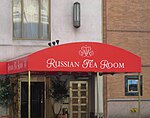Alwyn Court

The Alwyn Court, also known as The Alwyn, is an apartment building at 180 West 58th Street, at the southeast corner with Seventh Avenue, in the Midtown Manhattan neighborhood of New York City. The Alwyn Court was built between 1907 and 1909 and was designed by Harde & Short in the French Renaissance style. It is one of several luxury developments constructed along Seventh Avenue during the late 19th and early 20th century. The building is thirteen stories tall. Its facade is clad with elaborate terracotta ornamentation in the Francis I style, with a main entrance on Seventh Avenue and 58th Street. Inside is an octagonal courtyard with a painted facade by artist Richard Haas, as well as a location of the Petrossian caviar bar. The Alwyn Court was originally built with twenty-two elaborately decorated apartments, two on every floor, which typically had fourteen rooms and five bathrooms. The interior was subdivided into 75 apartments in 1938. The Alwyn Court was named after Alwyn Ball Jr., one of the building's developers. Despite a fire shortly after its opening, the Alwyn Court quickly became one of New York City's most expensive apartment buildings. During the early 20th century, ownership changed several times. By the 1930s, the last luxury tenant had moved out, and the building's interior was completely rebuilt. The Alwyn Court was made a New York City designated landmark in 1966, and added to the National Register of Historic Places in 1979. The building was renovated and converted to cooperative apartments in 1980, and the facade was restored in the late 1990s and early 2000s.
Excerpt from the Wikipedia article Alwyn Court (License: CC BY-SA 3.0, Authors, Images).Alwyn Court
West 58th Street, New York Manhattan
Geographical coordinates (GPS) Address External links Nearby Places Show on map
Geographical coordinates (GPS)
| Latitude | Longitude |
|---|---|
| N 40.765833333333 ° | E -73.979444444444 ° |
Address
Alwyn Court
West 58th Street 180-182
10019 New York, Manhattan
New York, United States
Open on Google Maps







